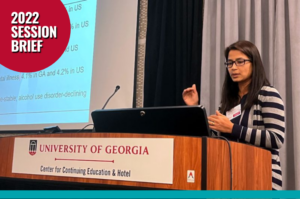By Haoyue Xiang
 Picture this scenario: A high school student breaks up with his girlfriend. He skips tennis practice. He’s despondent. He doesn’t want to do anything with friends. He starts to fail his classes. One day, he slips a note into a friend’s locker that says, “We’re having the epic party of a lifetime tonight.”
Picture this scenario: A high school student breaks up with his girlfriend. He skips tennis practice. He’s despondent. He doesn’t want to do anything with friends. He starts to fail his classes. One day, he slips a note into a friend’s locker that says, “We’re having the epic party of a lifetime tonight.”
When you’re not a trained mental health expert, you may not see these behaviors as warning signs of suicide. And if you do, how do you support and help this teen?
That’s the question two University of Georgia researchers addressed in a session presented at the annual State of the Public’s Health conference held on October 27, 2022, in Athens.
Diane Bales, a professor in the College of Family & Consumer Sciences (FACS), and Janani R. Thapa, an associate professor in the College of Public Health (CPH), discussed new work outlining the prevalence and healthcare costs of mental health among youth in Georgia and shared programs to address these challenges, with a primary focus on the Youth Mental Health First Aid national curriculum.
Thapa presented the findings of two analyses she conducted with colleagues from the CPH’s Economic Evaluation Research Group – one using self-reported data from middle and high school students across the U.S., and the second using Medicaid application dataset.
According to their analysis, 1 in 6 children in the U.S. between the ages of two and eight-years-old has a mental, behavioral or developmental disability. And although the national rate of mental health disabilities among adolescents has decreased in recent years, it is increasing in Georgia.
And many of these teens face access barriers to treatment, in both rural and urban communities. And the data showed low rates of health care utilization suggest that the high cost of mental health care is also a factor.
It is more expensive to have patients come back again and again. More research is needed to under where disparities exist and why they exist, said Thapa.
“That means the researchers collaboration to identify why and there are disparity and disparity exist,” Thapa said.
Inability to access care is another reason why community-based mental health programs may be an effective tool in addressing adolescent mental challenges.
The Youth Mental Health First Aid national curriculum, overseen by the National Board of Mental Health, teaches adults and community members how to assist young people in coping with mental health issues and seeking the professional treatment if they need it.
Bales said that the curriculum is part of a secondary defense model for addressing youth mental health challenges, and it could be particularly useful in rural areas. It provides a framework to help teens talk about the struggles they may be feeling.
“It’s early identification of mental health challenges, not letting a young person get to the point where they’re considering suicide,” Bales said.
